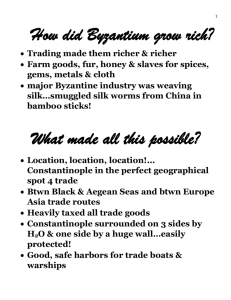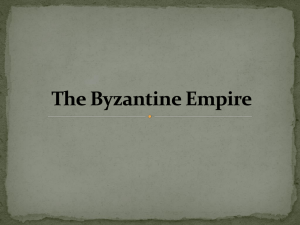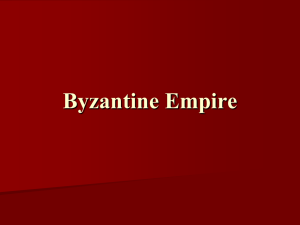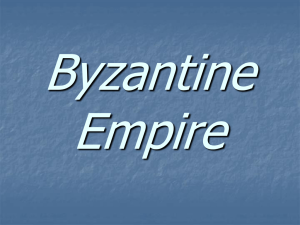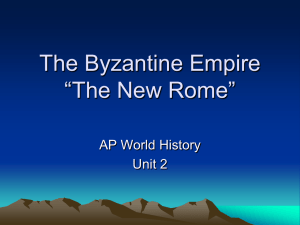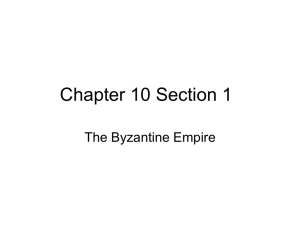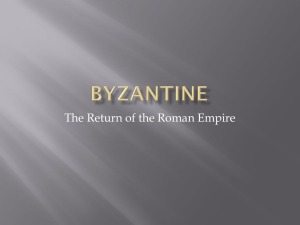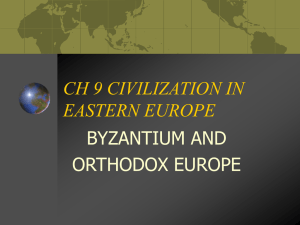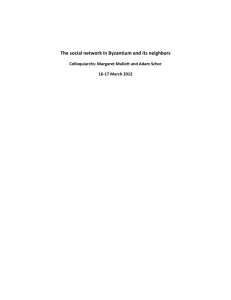Packet 11
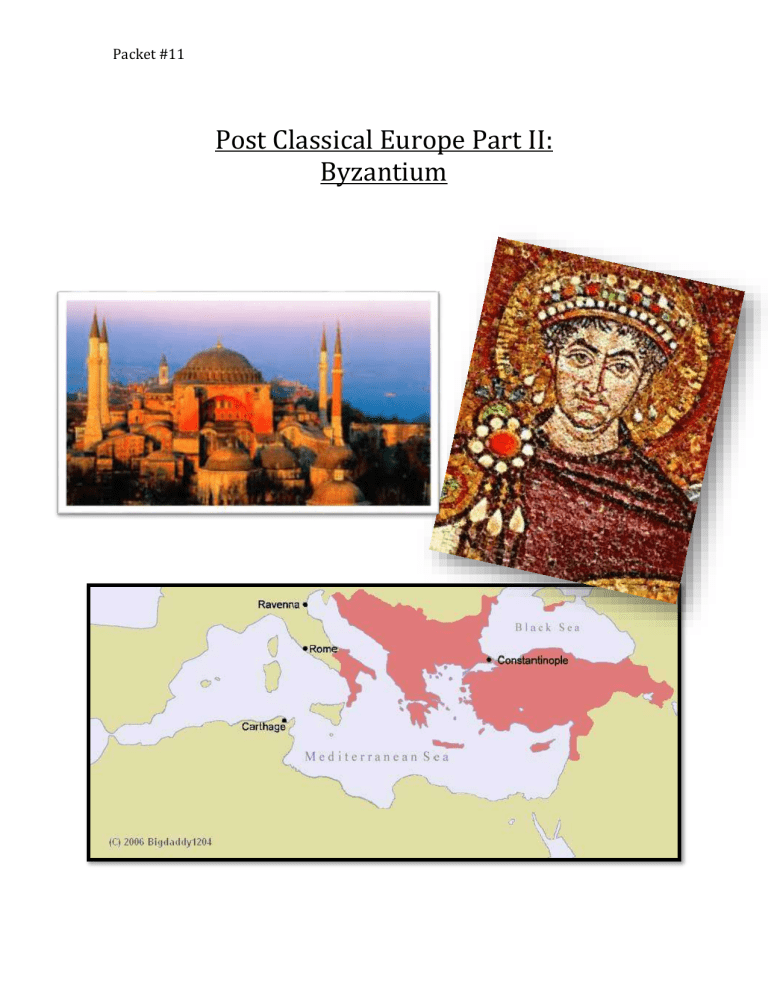
Packet #11
Post Classical Europe Part II:
Byzantium
Packet #11
In this packet you will learn about….
Byzantium
The Russian State Emerges o Source: Traditions and Encounters by Jerry Bentley
Environment:
Situated on a defensible peninsula and blessed with a magnificent natural harbor known as the Golden Horn, Byzantium had the potential to control the Bosporus, the strait of water leading from the Black Sea to the Sea of
Marmara and beyond to the Dardanelles, the Aegean, and the Mediterranean.
Convenient access to rich lands of Anatolia, southwestern Asia, and southeastern Europe. Sea lanes linked the city to ports throughout the
Mediterranean basin
Political:
Recognizing its strategic value, the Roman Emperor Constantine designated
Byzantium the site of a new imperial capital, which he named
Constantinople (city of Constantine).
He built the new capital partly because the eastern Mediterranean was the wealthiest and most productive region of the Roman Empire and partly because relocation enabled him to maintain close watch over Persia and the
Germanic peoples.
The imperial government moved to Constantinople after 330 and the new capital reached metropolitan dimensions.
Constantine filled the city with libraries, museums and artistic treasures. The city kept the name Constantinople until it fell to the Ottoman Turks in 1453.
Caesarpapism: As a Christian, Constantine could not claim the divine status that some of the earlier Roman emperors had appropriated for themselves.
As the first Christian emperor, however, he claimed divine favor and sanction
for his rule. He intervened in theological disputes and used his political position to support the views he considered orthodox while condemning those he deemed heretical. He created the policy of casearpapism, whereby the emperor not only ruled as secular lord but also played an active and prominent role in ecclesiastical affairs. o Following Constantine’s example, Byzantine emperors presented themselves as exalted, absolute rulers. o High officials presented themselves to the emperor as slaves.
Justinian and Theodora: Reigned from 527-565 c.e. Energetic worker known to his subjects as the
“sleepless emperor” o Theodora was his ambitious wife
Packet #11 o Like Constantine, Justinian lavished resources on the imperial capital.
His most notable construction project was the Hagia Sophia “holy wisdom” (pictured). o Justinian’s Code:
Most significant political contribution was his codification of
Roman law. The origins of Roman law went back to the times of the kings of Rome, and even though earlier scholars worked to codify the law, it had become a confusing mass of conflicting injunctions.
Justinian issued the corpus iuris civilis - a systematic review of
Roman law. o Byzantine conquests:
Justinian’s most ambitious venture was his effort to re-conquer the Western Roman Empire from Germanic peoples and reestablish Roman authority through the Mediterranean basin.
Between 533 and 565 Byzantine forces gained control over
Italy, Sicily, and much of northwestern Africa, and southern
Spain. Yet Byzantium did not possess the resources to sustain a long term occupation and consolidate those conquests. Shortly after Justinian’s death.
Justinian’s efforts showed that the classical Roman empire was beyond recovery
Muslim expansion posed a larger threat from the South.
The Theme System: A reorganization of Byzantine society. They placed an imperial province called a theme under the authority of a general, who assumed responsibility for both its military defense and its civil administration. Generals received their appointments from the emperor, who closely monitored their activities to prevent decentralization of power and authority. Generals recruited armies from the ranks of free peasants, who received allotments of land for their military service.
Generals recruited armies from ranks of free peasants, who received allotments of land for their military service.
Armies raised under the theme system were effective fighting forces
Enabled Byzantium to expand its influence between the ninth and twelfth centuries.
Economy:
Agricultural surpluses supported manufacturing in Byzantium’s cities, especially Constantinople, which was already a manufacturing megalopolis in classical times.
The city was home to throngs of artisans and crafts workers, not to mention thousands of imperial officials and bureaucrats. Glassware, linen and woolen textile, gems, jewelry, and fine work in gold and silver –boasted by Byzantine crafts workers.
Packet #11
Silk: (people wearing silk pictured) In the sixth century, crafts workers added high quality silk textiles to the list of products manufactured in the Byzantine Empire.
Supposedly two monks smuggled silkworm eggs out of
China into the Byzantine empire. Nevertheless, silk textiles soon made major contributions to the
Byzantine economy.
By the late sixth century, Byzantine silks matched the quality of Chinese textiles, and Byzantium became the principal supplier of the fashionable fabric to lands in the Mediterranean basin. The silk industry was so important to the Byzantine economy that the government closely supervised every step in its production and sale.
Regulations allowed individuals to participate in only one activity, such as weaving, dyeing, or sales—to prevent the creation of a monopoly by a few wealthy and powerful entrepreneurs.
Trade: Constantinople served as a main clearinghouse for trade in the western part of Eurasia. Merchants of Constantinople maintained commercial links with manufacturers and merchants in central Asia, Russia,
Scandinavia, northern Europe, and the lands of the Black Sea and the
Mediterranean basin. Traded regularly with the Muslim counterparts in
Persia, Syria, Palestine, and Egypt (when they weren’t fighting)
Served as a western anchor of the Eurasian trading network that revived the silk roads of classical times. Silk and porcelain came to Constantinople from
China, spices from India. Carpets arrived from Persia and woolen textiles from Western Europe. Byzantine subjects consumed some commodities from distant lands, but they redistributed most products, often after adding to their value by further processing-by fashion jewelry out of gems imported from India, for example.
Social:
An Urban Society: The Byzantine Empire was rich in large, prosperous, cosmopolitan cities, including Alexandria, Antioch, and Damascus, to mention a few.
Until the Muslim conquests of the late seventh and eighth centuries,
Byzantium was the world’s most urbanized society, and residents of it cities enjoyed the benefits and observed urban traditions inherited from classical
Mediterranean world.
Constantinople was “the City”
City Life: Aristocrats maintained enormous palaces that included courtyards, reception halls, libraries, chapels, and quarters for members of the extended family as well as servants and slaves.
Packet #11
Women lived in separate apartments and did not receive male visitors from outside the household. Upper class women generally wore veils, to discourage the attention of men outside their own families.
Dwellings of less privileged classes were not so splendid. Artisans and crafts workers commonly lived in rooms above their shops, while clerks and government officials occupied multistory apartment buildings. Workers and the poor lived in rickety tenements where they shared kitchens and sanitary facilities with their neighbors.
City was the cite of baths, taverns and restaurants. Hippodrome was a large stadium next to the palace where there were chariot races, athletics etc.
Religion:
Patriarchs: Patriarchs of Constantinople were powerful officials, but the did not enjoy their independence of their brethren of the west (the Pope).
Following the tradition of caesarpapism inaugurated by Constantine in the
4 th century, Byzantine emperors treated the church as a department of the state. They appointed patriarchs, and they instructed patriarchs to deliver sermons that supported imperial policy.
Two Churches: The churches of Constantinople and Rome experienced increasing friction after the sixth century. Tensions mirrored political strains, such as deep resentment in Byzantium after Charlemagne accepted the title of emperor of form the pope in Rome.
Different views on religious and theological issues.
The iconoclastic movement of the eighth and ninth centuries was one focus of difference. Western theologians regarded religious images as perfectly appropriate aids to devotion and resented Byzantine claim to the contrary.
Iconoclasts took offense at the efforts of their Roman counterparts to have images restored in Byzantium.
Christian Churches based in Constantinople and Rome disagreed on many other points. Some ritual and doctrinal difference concerned forms of worship and the precise wording of theological teachings. One example is that Byzantine priests shaved their beards and used unleavened rather than leavened bread when saying Mass. Another issue was the relationship between Holy Spirit, God, and Jesus.
Schism: Alongside ritual and doctrinal differences, the Byzantine patriarch and the Roman popes disputed their respective rights and powers.
Patriarchs argued for the autonomy of all major Christian jurisdictions whereas popes asserted the primacy of Rome as the sole seat for all
Christendom.
Ultimately relations became so strained that the eastern and western churches went separate ways.
In 1054 the patriarch and pope mutually excommunicated each other.
Packet #11
Refused toe recognize the other’s church as properly Christian.
After 1054 historians see eastern Christian church as the Eastern Orthodox
Church and in the west the Roman Catholic Church.
Russia:
People in Ukraine and Russia –diverse- Slavic, Baltic, Vikings.
Lived in a small state called Kievan Rus named for city of Kiev.
Emerged in 9th century.
Grew because of trade. Included Christians, Jews, Muslims.
Rus King Vladimir (pictured 956 - July 15, 1015) embraced
Eastern Orthodoxy (he chose this over Islam b.c. Muslims were forbidden to drink alcohol!). Eastern Orthodoxy took root in the
Russian people.
Embraced Cyrillic alphabet.
When Ottomans took over Byzantium, Russia considered itself the Third Rome.
Orthodoxy helped to create a Russian national identity.
Vladimir I, Grand Prince of Kiev and of all
Russia, was an outstanding political figure in ancient Russia. During his rule, Christianity was adopted in Russia. He is also known as St.
Vladimir. Russiapedia.com
NOTE: Byzantium and Russia are not the same place. They neighbor one another. Don’t be confused. See picture to right.
SOCIAL POLITICAL
ECONOMIC ENVIRONMENTAL
Packet #11
Vocabulary
Constantinople
Definition
Caesarpapism
Justinian and
Theodora
Hagia Sophia
Justinian’s
Code
The Theme
System
Patriarchs
Schism
Kievan Rus
King Vladimir
